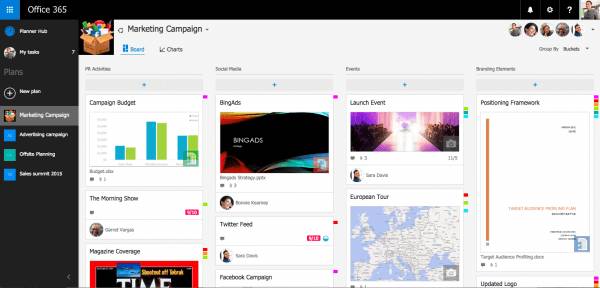When looking into project management software that is geared towards helping streamline your everyday tasks, it’s important to find an app that actually works for what you need, how you need it, and when you need it. One of the main questions our clients keep coming back to us and asking is how can we collaborate more effectively while managing our tasks? While there are many project management application tools out there, it’s important to understand what will give you the results you are looking for.
What is Microsoft Office 365 Planner?
Microsoft Office 365 Planner is Microsoft’s answer to project and task management and it’s already included with your Office 365 enterprise subscription. It provides a hub for team members to get organized quickly and manage all their documents. With Microsoft Planner, teams can easily create plans, organize and assign tasks to different users and to check on progress through those dashboards. Thus, providing a centralized place where teams can work together and files can be shared while providing visibility to your whole team.
There are two components to streamline your organization. Each “plan” (category or topic) in Microsoft Planner has its own Board, and within each Board, each work item or task is represented by a Card that can have due dates, attachments, categories and conversations associated with it. Team members receive an email notification whenever they are assigned a new Card or added to a conversation.

Every Card can have documents (or pictures) attached that automatically provide rich image previews, so it is easy to understand what the Card is about at a glance. In addition, Cards can be organized on the Board into customizable columns called Buckets, which can be prioritized and tagged with colored labels.
What are the pros to Microsoft Office 365 Planner?
- FREE with your Microsoft Office 365 License
- Integrate with all Office 365 tools
- Built in calendar feature – making it easy to set due dates on tasks
- Planner offers a screen called Planner Hub, where your tasks and time can be broken down into detailed reports on tasks, progress and where time has been spent.
- Visual Progress – the easy-to-navigate boards make it feel like you always have everything you need sitting right in front of you – plus you can colour code everything!
- You can view your team members assigned tasks across all boards, so you can see if any one person is overloaded.
- You can communicate with all members of a Plan via Outlook due to the native integration with Office 365; each plan is given an email address and its members all receive those emails.
- Because Planner is linked with Office 365, you don’t need to log in separately
What are the cons to Microsoft Office 365 Planner?
- No option to add non-team members to participate in Planner. If a user is not registered with your company via Office 365, they can’t participate in Planner.
- No @tagging to notify another person / send an email
- Only one checklist per task is allowed, 20 checkboxes max.
- Comments on tasks in Planner have character limits
- There is no easy way to send content between tasks, buckets or plans, you have to copy/paste
How Does Microsoft Planner Compare to Third Party Planner Apps?
Most third-party collaboration and work management tool applications are set up to organize your projects, to do lists, ideas, and tasks all in one place. In one glance, it can tell you which projects are being currently worked on, who’s working on what, and where something is in its process of completion.
Similar to Microsoft Planner, third-party planner apps are designed to help your team collaborate and get things done more efficiently.
While most third-party apps, like Trello, are accessed through a separate application that requires licensing based on types of users. Planner however, is an integrated solution that is set to address both project collaboration and teamwork.
There is also no additional licensing cost for Planner, making it easy to adopt and simple to use!
How Microsoft Office 365 Planner Can Accelerate Your Business?
Planner’s most obvious strength lies in its integration with other Office 365 tools, such as Teams and Project. It not only empowers teams to effectively manage their tasks, but more importantly gives clear visibility to everyone on the team.
Planner sits somewhere between note-taking and list apps such as Microsoft’s To-Do software and is best used for teams looking to break down the plan primarily by tasks.
About 360 Visibility
At 360 Visibility we accelerate end-to-end cloud adoption with Microsoft’s secure Azure Cloud and the Dynamics suite of software, giving your business the best service, software, and experience. Our Business Impact Assessment and Cloud Consultation make achieving your business results easier and faster, no matter where you are in your digital transformation.



